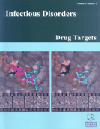-
s Prion Disease: Chemotherapeutic Strategies
- Source: Infectious Disorders - Drug Targets (Formerly Current Drug Targets - Infectious Disorders), Volume 12, Issue 2, Apr 2012, p. 144 - 160
-
- 01 Apr 2012
Abstract
Prion diseases, also known as transmissible spongiform encephalopathies, are invariably fatal neurodegenerative diseases for which there are no efficacious treatments. Thousands of compounds have been screened for anti-prion effect, and yet of those that have effect in vitro, very few show effect in vivo, especially if administered in the later stages of disease. However, with new techniques for early diagnosis being developed, and with further insight into the pathogenesis of early disease, including the role of oligomers and the contribution of accessory molecules and signalling cascades, the chance of finding a therapeutic strategy is increasing. Beyond clinical therapy, there is increasing need to find effective decontaminants for blood supplies, as variant Creutzfeldt Jakob Disease (vCJD) is transmissible by blood. Non-toxic preventative therapies are also needed, with ongoing cases of Bovine Spongiform Encephalopathy (BSE) and the spread of Chronic Wasting Disease (CWD) being a growing concern. A primary target for therapy has been the conversion of the normal form of prion protein (PrPC) to its abnormal counterpart (PrPSc). Many of the chemotherapeutic agents with antiprion effect share structural similarities, often being polyanionic or polycyclic. They may directly bind PrPC or PrPSc, or they may redistribute, sequester, or down-regulate PrPC, thus preventing its conversion. There have also been some novel approaches, including trapping PrPSc in a multimeric form such that it can no longer cause conversion, increasing clearance of PrPSc, targeting accessory molecules which play a role in conversion, targeting pathways which lead to neurodegeneration, and stem cell therapy. It may be that a combination of compounds will be necessary for maximal effect and there is evidence that synergistic responses occur with dual therapy. This updated review focuses primarily on chemicalbased treatments in light of developments in diagnostic technologies, including results from recent clinical trials, and proposes some promising new targets for prion therapy.


